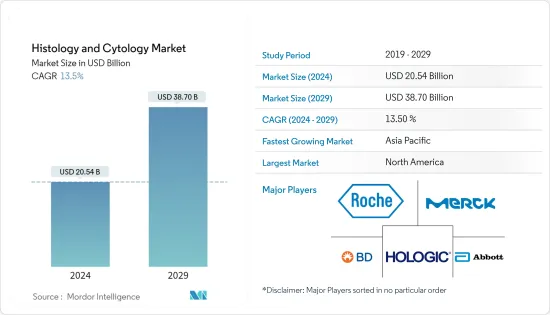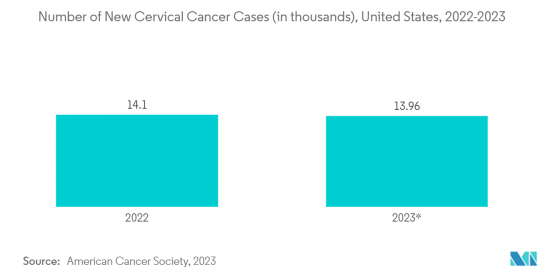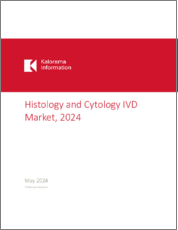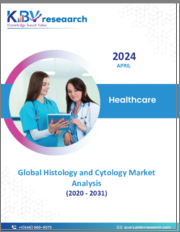
|
시장보고서
상품코드
1404353
조직학 및 세포학 : 시장 점유율 분석, 산업 동향 및 통계, 성장 예측(2024-2029년)Histology and Cytology - Market Share Analysis, Industry Trends & Statistics, Growth Forecasts 2024 - 2029 |
||||||
조직학 및 세포학 시장 규모는 2024년에 205억 4,000만 달러로 추정 및 예측되고, 2029년에는 387억 달러에 이를 전망이며, 예측 기간(2024-2029년)의 CAGR은 13.5%로 성장할 것으로 예측됩니다.

COVID-19는 시장 성장에 큰 영향을 미쳤습니다. 이것은 주로 팬데믹 중에 새로운 세포학 및 조직학 검사가 개발되었기 때문입니다. 예를 들어, 2022년 1월에 Frontiers에 의해 발표된 논문은 COVID-19 팬데믹학 동안 표본에 직접 접촉하지 않고 객담 세포학 검사를 수행하는 새로운 방법을 설명합니다. 게다가 2021년 2월에 PubMed Central에서 발표된 논문은 인도에서 실시한 연구에서 팬데믹 중에 수리된 세포학 표본이 92.6% 감소한 것으로 나타났습니다. 따라서 이러한 새로운 세포학 방법의 개척 및 세포학 검사의 감소는 유행 기간 동안 시장에 큰 영향을 미쳤습니다. 그러나 팬데믹이 침전된 현재 조사 대상 시장은 조사 예측 기간 동안 정상적인 성장을 이룰 것으로 예상됩니다.
조직학 및 세포학 시장의 성장 촉진요인으로서는 암의 유병률의 상승, 병리 검사실의 표준화의 진전, 진단 기술이나 분자 기술의 기술 진보 등을 들 수 있습니다.
암 유병률 증가는 조직학 및 세포학 검사가 암 진단에 주로 사용되기 때문에 시장 성장을 가속하는 주요 요인입니다. 예를 들어, 스페인암 등록 네트워크가 2021년 1월에 발표한 데이터에 따르면, 스페인에서는 전년에 추정 27만 6,200건의 신규 암 증례가 진단되고, 그 중 4만 3,600건이 대장암 증례, 3만 5,800건이 전립선암 증례, 3만 3,400건이 유방암 증례였습니다.
게다가 2022년 11월 Indian Journal of Medical Research가 발표한 논문에 따르면 인도에서는 암 환자의 발생률이 전년 146만명에서 2년 후 157만명으로 증가할 가능성이 높다고 추정 되었습니다. 100,000명당 대략 발생률의 2022년 전국 평균은 남성에서 100.4, 여성에서 95.6이었습니다. 따라서 세계 암의 유병률 증가는 시장 성장을 가속하는 주요 요인입니다.
또한 다양한 단체와 시장 진출 기업에 의한 제품 발매 등 신흥국 시장 개척도 시장 성장을 뒷받침해 조직학 및 세포학 제품의 채용 확대로 이어질 것으로 기대되고 있습니다. 예를 들어, 2022년 6월, 알모라 의과대학에서 세침 흡입 세포학(FNAC) 검사 시설이 개설되었습니다. 이 검사는 암과 같은 만성 질환의 조기 발견에 도움이 됩니다.
이와 같이 암 유병률의 상승 및 다양한 조직이나 시장 진출기업에 의한 제품 발매 등 신흥국 시장의 개척 등 위와 같은 요인이 예측 기간 중 조사 시장의 성장을 가속한다고 예상됩니다. 그러나, 병리조직학적 검사나 세포병리학적 검사에 있어서의 안전성 문제나 진단 정밀도의 문제, 진단 검사에 대한 일반 시민의 인식 부족이 시장 성장에 방해가 될 것으로 예상됩니다.
조직학 및 세포학 시장 동향
예측 기간 동안 자궁 경부암 부문이 큰 시장 점유율을 차지할 전망
세포학 검사는 자궁 경부암의 진단 및 스크리닝 모두에 유용합니다. 세포학 부문은 자궁 경부암의 유형에 따라 광범위한 용도가 있습니다. 기업이 분자진단에 더욱 주력하는 가운데 세포학은 자궁경부암의 진단에 중요한 역할을 할 것으로 예상됩니다.
자궁 경부암의 유병률 상승은 시장 성장을 가속하는 주요 요인입니다. 예를 들어, Cancer Australia가 2022년 8월에 갱신한 데이터에 따르면, 호주에서는 올해 추정 942례의 자궁경부암이 새롭게 진단되었으며, 이는 이 나라에서 진단된 최신 여성암 증례의 1.3% 를 차지하게 됩니다. 따라서 자궁경부암의 유병률이 높은 호주는 부문의 성장을 뒷받침할 것으로 예상됩니다.
또한 HPV와 암에 관한 ICO/IARC 정보센터가 2023년 3월에 갱신한 데이터에 따르면 독일에서는 매년 추정 4,666건의 자궁경부암 증례가 진단되고 있으며, 독일의 일반인구 여성의 약 3.2%가 자궁경부 인유두종 바이러스(HPV)-16/18 감염을 상시 보유하고 있는 것으로 추정되며 침윤성 자궁경부암의 76.5%가 HPV 16 또는 18에 기인하고 있습니다. 따라서 HPV와 관련된 자궁경부암의 유병률이 높은 것도 이 분야의 성장을 가속할 것으로 예상됩니다.
게다가 자궁경부암 검진에 대한 대처가 활발해지고 있는 것도, 이 분야의 성장을 높일 것으로 예상됩니다. 예를 들어, 2021년 12월, BC Cancer는 캐나다의 밴쿠버 섬 중앙부와 선샤인 코스트에서 가정에서 자궁 경부암 검진의 시험적 실시를 시작하고, 검진에 대한 액세스를 개선하고, 자궁 경부암 예방에 기여하고 있습니다.
이와 같이 자궁경부암의 유병률 상승 등 상기 요인으로부터 자궁경부암 세포학법 수요는 증가할 것으로 예상됩니다.

예측기간 중 북미가 시장에서 큰 점유율을 차지할 전망
북미는 노인 인구 증가, 암 이환율 증가, 암 검진에 대한 의식이 높아짐에 따라 조직학 및 세포학 시장에서 큰 시장 점유율을 차지할 것으로 예상됩니다. 예를 들어, 미국 암 협회의 2023년 보고서에 따르면, 미국에서는 올해 196만명 이상이 새롭게 암으로 진단될 전망입니다. 또한 미국에서 암으로 진단받는 사람의 80%는 55세 이상, 57%는 65세 이상입니다. 이와 같이 암의 유병률이 높고 이환 노인 인구가 증가함에 따라 진단제에 대한 수요가 시장 성장에 기여하고 있습니다.
또한 breastcancer.org의 2022년 1월 최신 정보에 따르면 국내 여성의 약 8명 중 1명(약 13%)이 평생 침윤성 유방암을 발병한다고 합니다. 이 출처에 따르면 2022년에는 미국 여성에서 침윤성 유방암의 추정 287,850례가 새롭게 진단될 전망이며, 비침윤성(in situ) 유방암의 5만1,400례도 새롭게 진단될 전망입니다. 같은 출처에 따르면 2022년에는 남성에서 약 2,710명의 침윤성 유방암이 새롭게 진단될 것으로 예상되고 있습니다. 남성의 평생 유방암 위험은 약 833분의 1입니다. 따라서 이러한 모든 요인이 조직학 및 세포학 시장의 추진에 도움이 될 것으로 예상됩니다.
미국에서의 제품 승인도 시장 성장에 기여할 것으로 예상됩니다. 예를 들어, 2021년 5월, Hologic는 미국 식품의약국(FDA)으로부터 세포학 처리 및 하류 용도의 시료 반송용 프로세서 「ThinPrep Genesis」의 시판전 승인을 취득했습니다.
게다가 첨단 치료법에 대한 인식과 확립된 의료 인프라의 존재는 또한 이 지역 시장 전체의 성장을 크게 뒷받침하고 있습니다.
조직학 및 세포학 업계 개요
조직학 및 세포학 시장은 적당한 경쟁이 있어, 복수의 대기업으로 구성되어 있습니다. 시장 점유율 측면에서 현재 몇몇 선도 기업들이 시장을 독점하고 있습니다. Abbott Laboratories, Becton, Dickinson and Company, F. Hoffmann-La Roche Ltd, Hologic Inc., Sysmex Corporation, Thermo Fisher Scientific Inc., Trivitron Healthcare 등이 주요 진출기업입니다.
기타 혜택 :
- 엑셀 형식 시장 예측(ME) 시트
- 3개월간의 애널리스트 서포트
목차
제1장 서론
- 조사의 전제조건 및 시장 정의
- 조사 범위
제2장 조사 방법
제3장 주요 요약
제4장 시장 역학
- 시장 개요
- 시장 성장 촉진요인
- 암의 유병률 상승
- 병리 검사실의 표준화의 진전
- 진단과 분자기술의 기술적 진보
- 시장 성장 억제요인
- 병리 조직학적 검사 및 세포 병리학적 검사의 안전성과 진단 정밀도의 문제
- 진단 검사에 대한 일반 시민의 인식 부족
- Porter's Five Forces 분석
- 공급기업의 협상력
- 구매자 및 소비자의 협상력
- 신규 참가업체의 위협
- 대체품의 위협
- 경쟁 기업간 경쟁 관계의 강도
제5장 시장 세분화(시장 규모-달러)
- 검사 유형별
- 조직 검사
- 세포학
- 유방암
- 자궁경부암
- 기타
- 검사 유형별
- 현미경 검사
- 세포유전학적 검사
- 핵형 검사
- 형광 in-situ 하이브리드화(FISH)
- 중합효소 연쇄반응
- 기타 현미경 검사
- 분자유전학검사
- 플로우 사이토메트리
- 현미경 검사
- 최종 사용자별
- 병원 및 클리닉
- 학술기관 및 연구기관
- 기타 최종 사용자
- 지역별
- 북미
- 미국
- 캐나다
- 멕시코
- 유럽
- 독일
- 영국
- 프랑스
- 이탈리아
- 스페인
- 기타 유럽
- 아시아태평양
- 중국
- 일본
- 인도
- 호주
- 한국
- 기타 아시아태평양
- 중동 및 아프리카
- GCC 국가
- 남아프리카
- 기타 중동 및 아프리카
- 남미
- 브라질
- 아르헨티나
- 기타 남미
- 북미
제6장 경쟁 구도
- 기업 프로파일
- Abbott
- Becton Dickinson and Company
- Danaher Corporation
- F. Hoffmann-La Roche Ltd
- Hologic Inc.
- Merck KGaA
- PerkinElmer Inc.
- Sysmex Corporation
- Thermo Fisher Scientific Inc.
- Trivitron Healthcare
제7장 시장 기회 및 앞으로의 동향
AJY 24.01.26
The Histology and Cytology Market size is estimated at USD 20.54 billion in 2024, and is expected to reach USD 38.70 billion by 2029, growing at a CAGR of 13.5% during the forecast period (2024-2029).
COVID-19 had a significant impact on the growth of the market. This is mainly due to the development of new cytology and histology tests during the pandemic. For instance, an article published by Frontiers in January 2022 stated a new method for the sputum cytology test without direct contact with specimens during the COVID-19 pandemic. Moreover, in an article published by PubMed Central in February 2021, a study was conducted in India, which showed a 92.6% reduction in cytology samples received during the pandemic. Thus, the development of such new cytology methods and the reduction in cytology tests had a significant impact on the market during the pandemic period. However, as the pandemic has subsided, the studied market is expected to have normal growth during the forecast period of the study.
The propelling factors for the growth of the histology and cytology market include the rising prevalence of cancer, increasing standardization of pathological laboratories, and technological advancements in diagnostic and molecular techniques,
The increasing prevalence of cancer is a major factor driving the market growth as histology and cytology tests are majorly used to diagnose cancer. For instance, according to the data published by the Spanish Network of Cancer Registries in January 2021, an estimated 276.2 thousand new cases of cancer were diagnosed in Spain in the previous year out of which 43.6 thousand were colorectal cancer cases, 35.8 thousand were prostate cancer cases, and 33.4 thousand breast cancer cases were diagnosed.
Moreover, according to an article published by the Indian Journal of Medical Research in November 2022, it was estimated that in India, the incidence of cancer cases would likely increase from 1.46 million in the previous year to 1.57 million in two years. The national average for the year 2022 of the crude rate of incidence per 100,000 was 100.4 for males and 95.6 for females. Thus, the increasing prevalence of cancer worldwide is a major factor driving the market growth.
Furthermore, the developments such as product launches by various organizations and market players are also expected to boost the market growth, leading to a higher adoption of histology and cytology products. For instance, in June 2022, the Fine Needle Aspiration Cytology (FNAC) test facility has been launched at the Almora Medical College. This test helps in the detection of chronic diseases like cancer, at an early stage.
Thus, the above mentioned factors such as the rising prevalence of cancer and the increasing developments such as product launches by various organizations and market players are expected to drive the growth of the studied market during the forecast period. However, safety issues and diagnostic accuracy issues with histopathological and cytopathological tests and the lack of awareness among the public for diagnostic tests are expected to hinder the market growth.
Histology and Cytology Market Trends
Cervical Cancer Segment is Expected to Have a Significant Market Share During the Forecast Period
Cytology tests are useful for both the diagnosis and screening of cervical cancer. The cytology segment has a wide range of applications in cervical cancer types. As companies focus more on molecular diagnosis, cytology is expected to play a vital role in the diagnosis of cervical cancer.
The rising prevalence of cervical cancer is a major factor driving the market growth. For instance, according to the data updated by Cancer Australia in August 2022, an estimated 942 new cases of cervical cancer were diagnosed in Australia in the current year, which will account for 1.3% of the latest female cancer cases diagnosed in the country. Thus, the country's high prevalence of cervical cancer is expected to boost segment growth.
Moreover, according to the data updated by ICO/IARC Information Centre on HPV and Cancer in March 2023, an estimated 4,666 cervical cancer cases are diagnosed in Germany every year, and about 3.2% of women in the general population of Germany are estimated to harbour cervical human papillomavirus (HPV)-16/18 infection at a given time, and 76.5% of invasive cervical cancers are attributed to HPVs 16 or 18. Thus, the country's high prevalence of HPV-related cervical cancers is also expected to enhance segment growth.
Moreover, the rising cervical cancer screening initiatives are also expected to enhance segment growth. For instance, in December 2021, BC Cancer launched an at-home cervix screening pilot in Central Vancouver Island and the Sunshine Coast in Canada, improving access to screening and helping to prevent cervical cancer.
Thus, owing to the above factors, such as the rising prevalence of cervical cancer, the demand for cervical cancer cytological methods is expected to increase.

North America is Expected to Hold a Significant Share in the Market Over the Forecast Period
North America is expected to hold a significant market share in the histology and cytology market due to the increasing geriatric population, growing cancer incidence, and rising awareness about cancer screening in this region. For instance, according to the American Cancer Society's report in 2023, over 1.96 million new cancer cases are expected to be diagnosed in the United States in the current year. Additionally, 80% of the people diagnosed with cancer in the United States are 55 or older, and 57% are 65 or older. Thus, due to the high prevalence of cancer and the rising affected geriatric population, the demand for diagnostics contributes to the market's growth.
Moreover, according to the January 2022 update by breastcancer.org, around 1 in 8 women in the country (about 13%) develop invasive breast cancer over their lifetime. The same source reports that, in 2022, an estimated 287,850 new cases of invasive breast cancer are expected to be diagnosed in women in the United States, as well as 51,400 new cases of non-invasive (in situ) breast cancer. As per the same source, about 2,710 new cases of invasive breast cancer are expected to be diagnosed in men in 2022. A man's lifetime risk of breast cancer is about 1 in 833. Hence, all these factors are expected to help propel the histology and cytology market.
Product approvals in the United States are also expected to contribute to the market's growth. For instance, in May 2021, Hologic received the United States Food and Drug Administration's premarket approval of the Company's ThinPrep Genesis processor for cytology processing and specimen transfer for downstream applications.
Furthermore, awareness about advanced therapeutics and the presence of well-established healthcare infrastructure is also fueling the growth of the overall regional market to a large extent.
Histology and Cytology Industry Overview
The histology and cytology market is moderately competitive and consists of several major players. In terms of market share, few of the major players are currently dominating the market. Some of the key players operating are Abbott Laboratories, Becton, Dickinson and Company, F. Hoffmann-La Roche Ltd, Hologic Inc., Sysmex Corporation, Thermo Fisher Scientific Inc., and Trivitron Healthcare.
Additional Benefits:
- The market estimate (ME) sheet in Excel format
- 3 months of analyst support
TABLE OF CONTENTS
1 INTRODUCTION
- 1.1 Study Assumptions and Market Definition
- 1.2 Scope of the Study
2 RESEARCH METHODOLOGY
3 EXECUTIVE SUMMARY
4 MARKET DYNAMICS
- 4.1 Market Overview
- 4.2 Market Drivers
- 4.2.1 Rising Prevalence of Cancer
- 4.2.2 Increasing Standardization of Pathological Laboratories
- 4.2.3 Technological Advancements in Diagnostic and Molecular Techniques
- 4.3 Market Restraints
- 4.3.1 Safety Issues and Diagnostic Accuracy Issues with Histopathological and Cytopathological Tests
- 4.3.2 Lack of Awareness among the Public for Diagnostic Tests
- 4.4 Porter's Five Forces Analysis
- 4.4.1 Bargaining Power of Suppliers
- 4.4.2 Bargaining Power of Buyers/Consumers
- 4.4.3 Threat of New Entrants
- 4.4.4 Threat of Substitute Products
- 4.4.5 Intensity of Competitive Rivalry
5 MARKET SEGMENTATION (Market Size by Value - USD)
- 5.1 By Type of Examination
- 5.1.1 Histology
- 5.1.2 Cytology
- 5.1.2.1 Breast Cancer
- 5.1.2.2 Cervical Cancer
- 5.1.2.3 Others
- 5.2 By Test Type
- 5.2.1 Microscopy Tests
- 5.2.1.1 Cytogenic Tests
- 5.2.1.1.1 Karyotyping
- 5.2.1.1.2 Fluorescent In-situ Hybridization (FISH)
- 5.2.1.2 Polymerase Chain Reaction
- 5.2.1.3 Other Microscopy Tests
- 5.2.2 Molecular Genetics Tests
- 5.2.3 Flow Cytomtery
- 5.2.1 Microscopy Tests
- 5.3 By End User
- 5.3.1 Hospitals and Clinics
- 5.3.2 Academic and Research Institutes
- 5.3.3 Other End Users
- 5.4 Geography
- 5.4.1 North America
- 5.4.1.1 United States
- 5.4.1.2 Canada
- 5.4.1.3 Mexico
- 5.4.2 Europe
- 5.4.2.1 Germany
- 5.4.2.2 United Kingdom
- 5.4.2.3 France
- 5.4.2.4 Italy
- 5.4.2.5 Spain
- 5.4.2.6 Rest of Europe
- 5.4.3 Asia-Pacific
- 5.4.3.1 China
- 5.4.3.2 Japan
- 5.4.3.3 India
- 5.4.3.4 Australia
- 5.4.3.5 South korea
- 5.4.3.6 Rest of Asia-Pacific
- 5.4.4 Middle East and Africa
- 5.4.4.1 GCC
- 5.4.4.2 South Africa
- 5.4.4.3 Rest of Middle East and Africa
- 5.4.5 South America
- 5.4.5.1 Brazil
- 5.4.5.2 Argentina
- 5.4.5.3 Rest of South America
- 5.4.1 North America
6 COMPETITIVE LANDSCAPE
- 6.1 Company Profiles
- 6.1.1 Abbott
- 6.1.2 Becton Dickinson and Company
- 6.1.3 Danaher Corporation
- 6.1.4 F. Hoffmann-La Roche Ltd
- 6.1.5 Hologic Inc.
- 6.1.6 Merck KGaA
- 6.1.7 PerkinElmer Inc.
- 6.1.8 Sysmex Corporation
- 6.1.9 Thermo Fisher Scientific Inc.
- 6.1.10 Trivitron Healthcare

















